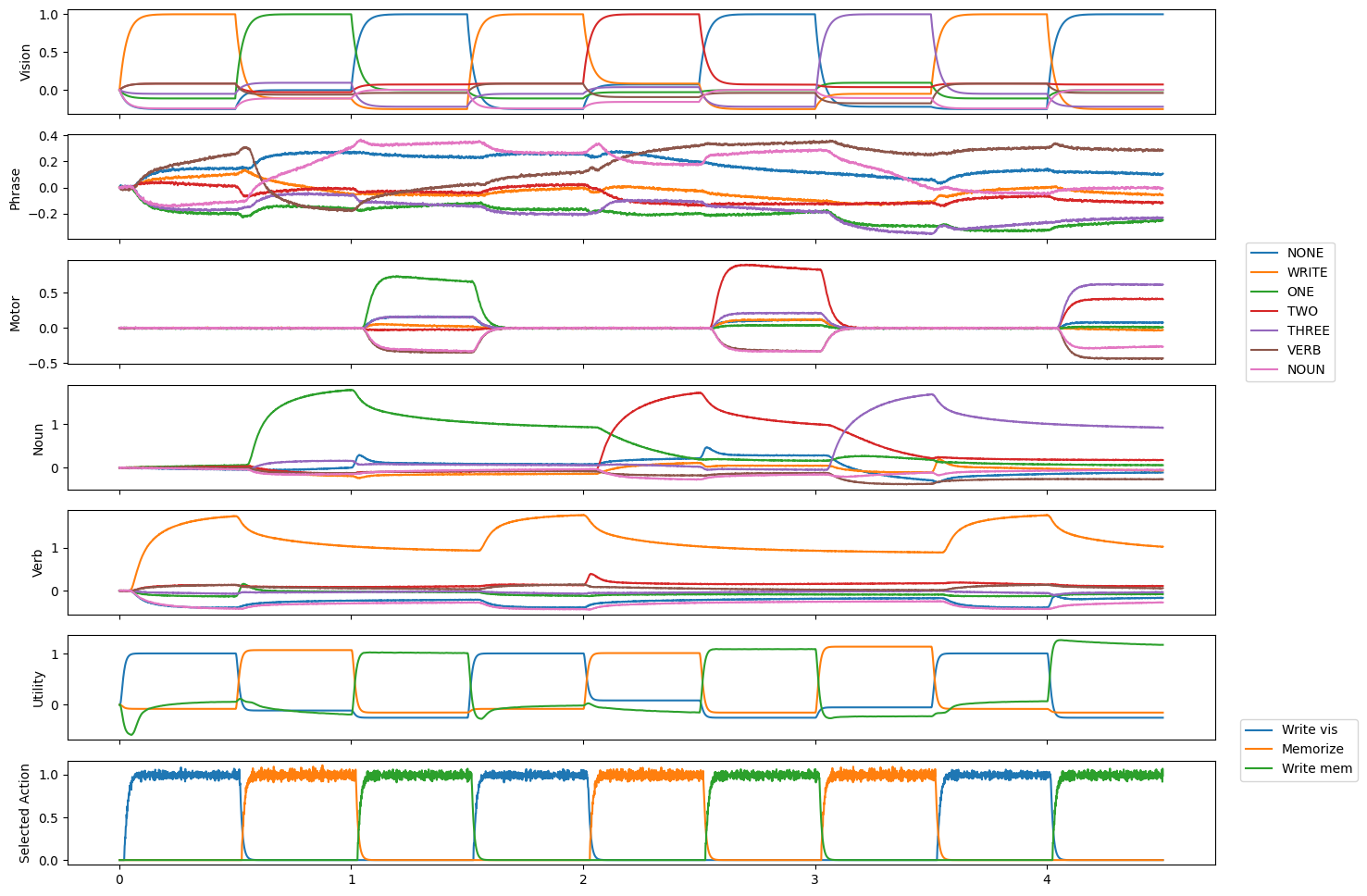Note
This documentation is for a development version. Click here for the latest stable release (v1.3.0).
Parsing simple commands¶
This example is a simplified version of the language parsing model presented in Stewart & Eliasmith, 2013. Please refer to that paper for the high-level details.
[1]:
%matplotlib inline
import nengo
import matplotlib.pyplot as plt
import nengo_spa as spa
seed = 0
Step 1: Create the model¶
[2]:
sequence = "WRITE ONE NONE WRITE TWO NONE THREE WRITE NONE".split()
def input_vision(t):
index = int(t / 0.5) % len(sequence)
return sequence[index]
# Number of dimensions for the SPs
dimensions = 64
# Make a model object with the SPA network
model = spa.Network(label="Parser", seed=seed)
n_per_dim = 50
with model:
# Specify the modules to be used
vision = spa.Transcode(input_vision, output_vocab=dimensions)
phrase = spa.State(dimensions, neurons_per_dimension=n_per_dim)
motor = spa.State(dimensions, neurons_per_dimension=n_per_dim)
noun = spa.State(dimensions, feedback=1.0, neurons_per_dimension=n_per_dim)
verb = spa.State(dimensions, feedback=1.0, neurons_per_dimension=n_per_dim)
# Specify the action mapping
none_vision_cond = spa.dot(
spa.sym.NONE - spa.sym.WRITE - spa.sym.ONE - spa.sym.TWO - spa.sym.THREE, vision
)
num_vision_cond = spa.dot(vision, spa.sym.ONE + spa.sym.TWO + spa.sym.THREE)
with spa.ActionSelection() as action_sel:
spa.ifmax("Write vis", spa.dot(vision, spa.sym.WRITE), vision >> verb)
spa.ifmax("Memorize", num_vision_cond, vision >> noun)
spa.ifmax(
"Write mem",
0.5 * (none_vision_cond + spa.dot(phrase, spa.sym.WRITE * spa.sym.VERB)),
phrase * ~spa.sym.NOUN >> motor,
)
noun * spa.sym.NOUN + verb * spa.sym.VERB >> phrase
Step 2: Probe the output¶
[3]:
with model:
p_vision = nengo.Probe(vision.output, synapse=0.03)
p_phrase = nengo.Probe(phrase.output, synapse=0.03)
p_motor = nengo.Probe(motor.output, synapse=0.03)
p_noun = nengo.Probe(noun.output, synapse=0.03)
p_verb = nengo.Probe(verb.output, synapse=0.03)
p_selected_actions = nengo.Probe(action_sel.thalamus.output, synapse=0.01)
p_utility = nengo.Probe(action_sel.bg.input, synapse=0.01)
Step 3: Run the model¶
[4]:
with nengo.Simulator(model) as sim:
sim.run(4.5)
Step 4: Plot the results¶
[5]:
vocab = model.vocabs[dimensions]
fig, ax = plt.subplots(7, 1, sharex=True, figsize=(16, 12))
ax[0].plot(sim.trange(), spa.similarity(sim.data[p_vision], vocab))
ax[0].set_ylabel("Vision")
ax[1].plot(sim.trange(), spa.similarity(sim.data[p_phrase], vocab))
ax[1].set_ylabel("Phrase")
ax[2].plot(sim.trange(), spa.similarity(sim.data[p_motor], vocab))
ax[2].legend(vocab.keys(), loc="right", bbox_to_anchor=(1.11, 0.5))
ax[2].set_ylabel("Motor")
ax[3].plot(sim.trange(), spa.similarity(sim.data[p_noun], vocab))
ax[3].set_ylabel("Noun")
ax[4].plot(sim.trange(), spa.similarity(sim.data[p_verb], vocab))
ax[4].set_ylabel("Verb")
ax[5].plot(sim.trange(), sim.data[p_utility])
ax[5].legend(tuple(action_sel.keys()), loc="right", bbox_to_anchor=(1.13, -0.1))
ax[5].set_ylabel("Utility")
ax[6].plot(sim.trange(), sim.data[p_selected_actions])
ax[6].set_ylabel("Selected Action")
[5]:
Text(0, 0.5, 'Selected Action')
